Digit (Discontinued)
Production Status: NLA (no longer available). The Digit was discontinued in 2017.
The Digit is a battery powered temperature and light logging device, which collects data in a remote location, and stores it to internal memory. When finished, the data can be downloaded via the convenient USB connector. Each data point is associated with a time stamp, so you know when it was collected.
Using the provided Otero software, starting, stopping, and downloading from the Digit is simple and easy. Data is summarized in the program view screens, or can be exported to .csv for further analysis. Temperature can be viewed in °C or °F, and real-time data is visible when connected over USB.
The Digit also supports field programmed firmware upgrades, just download the latest firmware file from the firmware page, and upgrade using the software package provided.
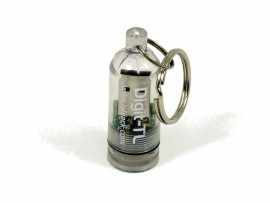
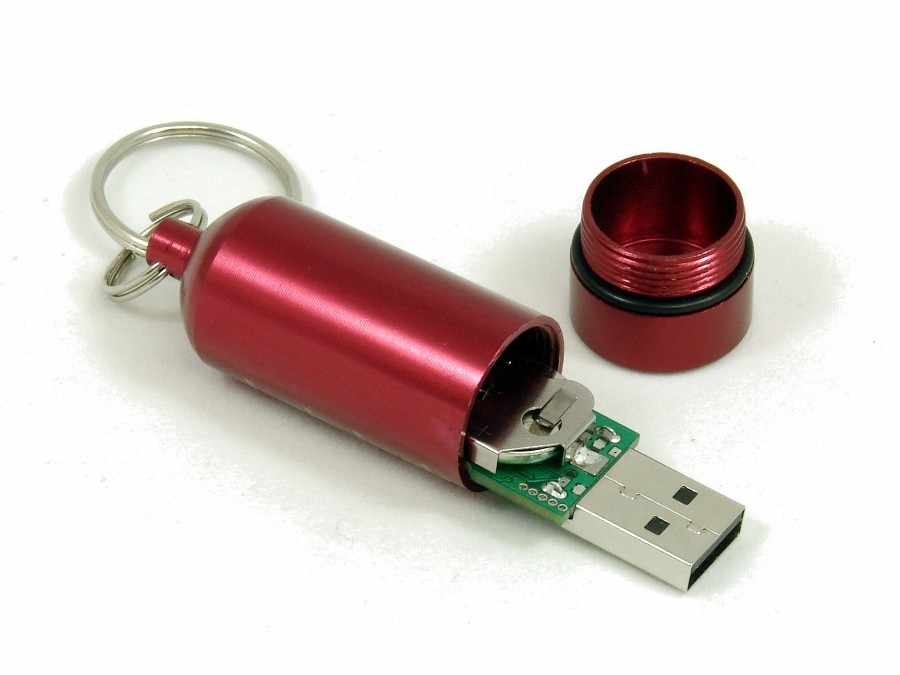
Subsections
Specifications
General
Memory | 260,000 Readings |
Logging rate | 10s, 30s, 1m, 10m, 30m, 1h, 6h |
LED Alarms | 2x user-defined thresholds |
LED indicators | Green, Red |
Battery life | 3.3 Years @ 25°C, 1m interval |
Battery type | 3V CR1632 coin cell, replaceable |
Software | Free, Windows only |
Communication | USB |
Real-time clock | ±2 seconds per day @ 25°C |
Memory-Wrap | No |
Single/Multi-Use | Multi-use |
Conformal Coating | Yes |
Operating Temperature | -35°C to +85°C (-31°F to +185°F) |
Solid-lid Plastic Enclosure (-TL) | IP67 - Water Resistant when properly closed * |
Aluminum Enclosure | IP68 - Not hermetically sealed ** |
Unlike many battery powered loggers in its class, the Digit does not require a special base to download stored data. Simply connect the Digit to an available USB port, and download stored information using the Otero software. The circuit board is protected by a thin film of conformal coating, which makes the Digit resistant to moisture, static discharges, and fingerprint oils. Still, it is recommended to take ESD precautions when handling the circuit board directly.
Note: Foreign objects inside the enclosure present a risk of damaging the board when the base is twisted off because they can catch and bind.
Note: For applications where the digit may be exposed to water or excess humidity that may condense onto the PCB consider placing a small desiccant packet in the case along with the Digit to prevent moisture build up inside the case. Remember to replace the packet when necessary.
* The plastic enclosure is hard to close properly. The rubber o-ring has a tendency to not properly seat itself in between the case lid and case body. Customers have reported humidity building up inside the plastic enclosure during long term testing resulting in failed measurements.
** We have not done thorough water resistance depth or duration testing other than our digit pond tests so we do not have exact depth or duration specifications to go along with the IP68 water resistance rating. These are two additional specifications that CNET recommends manufacturers also supply when indicating that devices have an IP68 rating. Our tests indicate that the aluminum enclosure is more water resistant than the plastic enclosure which we have rated for IP67 when properly closed so if a Digit-TL is being used in continuous submersion experiments we highly recommend the use of the aluminum enclosure. The case has an extra indentation so that the O-ring is more likely to seat itself properly in between the case lid and the case body resulting in a more water tight seal.
Temperature
SPECIFICATION | MIN | TYP. | MAX. | UNIT |
|---|---|---|---|---|
Temperature range* | -35(-31) |
| +85(185) | °C(°F) |
Temperature resolution |
| 0.067(0.12) |
| °C(°F) |
Temperature accuracy at +25°C (+77°F) |
| ±0.1(0.2) | ±0.5(0.9) | °C(°F) |
Temperature accuracy from 0°C to +65°C (+32°F to +149°F) |
| ±0.25(0.45) | ±0.5(0.9) | °C(°F) |
Temperature accuracy from -35°C to +85°C (-31°F to +185°F) |
| ±0.5(0.9) | ±1(1.8) | °C(°F) |
*Temperature readings are not restricted to the operating range, however continuous operation beyond the limits specified is not guaranteed.
Note: When connecting a Digit that has been exposed to temperature extremes (below 32 degrees F or above 100 degrees F) it is recommended to let the digit adjust back to room temperature for approximately 5 minutes before connecting the device to your computer.
The Digit uses a Texas Instruments TMP112 to record temperature. The TMP112 chip returns calibrated 12-bit readings which are saved to memory within the Digit-TL/TLH. For more information about this temperature sensor, see the TMP112 datasheet.
Light
SPECIFICATION | MIN | TYP. | MAX. | UNIT |
|---|---|---|---|---|
Light range | 10 |
| 12,000 |
|
Light readings are determined based on reverse leakage through the green LED, and thus have the strongest response to the green component of light. The readings are returned in a Lux range, but should not be considered accurate Lux values, and the values can vary greatly from device to device. Light readings are also dependent on temperature as we don't do a full light calibration process while manufacturing the devices.
Although not intended for calibrated light measurements, the light readings are useful to monitor changes in light levels. The most common application is simply monitoring whether some light source is on or off.
Because the light readings can vary greatly from device to device, the recommended usage is to take a particular device, see what it reports at different light levels in an environment of interest, and then use that information to interpret future readings.
Operating Sequence
The example below demonstrates a possible operating sequence for the Digit.
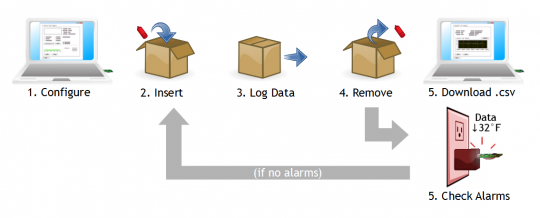
Configure the Digit on the computer: setting up the log interval, log items, alarm thresholds, etc.
Place the Digit into the measurement environment.
Data is logged for some period of time.
Remove the Digit from the measurement environment.
Either check the alarms using a 5V USB adapter, or connect it to a computer and view the whole data set.
Our customers have logged data in their pool, attic, garden, luggage, packages, the ocean, and many more. Most people will download the data once logging is finished, but if the data history needs to be analyzed quickly, the alarm thresholds can save a lot of time. Simply configure the alarms to trigger above/below some threshold condition, and the Digit will illuminate its Red LED (on USB connection) if the threshold has been exceeded.
LED Indicators
The moment the Digit is connected to a USB port, it will signal if a user threshold alarm has been triggered. If any alarms have been triggered the red LED will illuminate for 5 seconds. If the alarms are configured, but no alarms have been triggered, the Green LED will illuminate for 5 seconds. If user-alarms are disabled (set to None in software), the LEDs will not turn on. Additionally, while connected to USB, and for 6 log events after disconnect from USB, each read of temperature will cause the green LED to blink once.*
LEDs OFF: Alarm(s) are disabled.*
Green LED: Alarm(s) configured, but not yet triggered.
Red LED: Alarm(s) triggered.
Green and Red LEDs Blink: Two rapid blinks of both LEDs indicates that the device has recovered from a system error, such as a power failure from changing the battery.
There are no buttons on the device (to save on space, and make the enclosure more simplistic) so instead the LEDs are activated with USB power.
*LED behavior changed slightly starting with firmware v1.21, see firmware revision history for details.
Logging Information
Battery life
Logging at a rate faster than one reading per minute doesn't decrease battery life dramatically, but it does have a small impact. Take note of the table below if you are using the Digit in hot temperatures.
LOG (1M) \ TEMPERATURE | -35°C | 23°C | 85°C |
|---|---|---|---|
Temperature | 3.4µA | 3.9µA | 11.4µA |
Temperature, Light | 3.8µA | 4.4µA | 11.8µA |
*3 year lifespan calculated: 140mAh / 0.0048mA = 31818hr = 3.33yr
Notice that at cold temperatures the power consumption is actually lower than at room temp, but some batteries have reduced overall capacity at low temperatures, which can offset the reduction in power usage. High temperatures have the most dramatic impact on battery life, as the processor and peripherals simply consume more power when hot.
Memory
Memory will not run out for at least 15 days, at a log interval of 10 seconds, while logging temperature, and light. The memory lasts much longer if you select fewer log items, and change the logging to happen less frequently. For example, if you log temperature and light once per minute, the memory will last for 90 days.
Ex: 260,000(readings) / 2(log items) / 1(per minute) / 60(minutes) / 24(hours) = 90.277 days of memory
Reference the table below to find how long it will take to use up memory space.
| 10S | 30S | 1M | 10M | 30M | 1H | 6H |
|---|---|---|---|---|---|---|---|
Temperature | 30d | 90d | 181d | 4.9yr | 14.8yr | 29.7yr | 178yr |
Temperature, Light | 15d | 45d | 90d | 2.6yr | 7.4yr | 14.8yr | 89yr |
When the Digit runs out of space to store new readings, it will not wrap-around and erase older data, it will simply not store new information. When the Digit reaches 262,144 stored readings, the very last data point is repeatedly overwritten.
Alarm conditions
Threshold alarms are useful for applications where the data set is not important, as long as a specific threshold is not exceeded. There is no button on the Digit to check if an alarm occurred, so alarms can be checked by plugging it into a 5V adapter, or 5V USB battery as shown in the images below. Adapters are in-expensive, and can be purchased through a number of retailers. Shown below is a simple 5V adapter and a 11200mAh External USB Battery Pack.
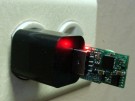
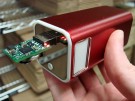
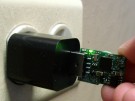
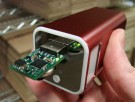
The concept is that the "checking station" will have a 5V USB power supply (battery or adapter). Simply plug the Digit in for a brief moment to check LEDs, and then place it back into the measurement environment. Also, only a single 5V USB supply is required to check as many Digits as desired.
A key in understanding threshold alarms is to realize that the act of checking an alarm would trigger the alarm, if it the alarm always occurred on the first out-of-threshold reading. Alarm arming must also be considered: what if it takes some time before the Digit reaches equilibrium with the measurement environment? The Digit has three ways to customize arming and triggering behavior, which allows for flexible alarm control.
1. Arm after time delay. Say it takes ~30 minutes to reach equilibrium with the measurement environment, and after this amount of time, you want to know if a specific threshold in temperature is exceeded. Configure the alarm arming condition for a pure time delay of 30 intervals, at a 1 minute log interval. Once configured, the alarm will not arm until 30 minutes have elapsed, and thus the alarm cannot be triggered until at least 31 minutes have elapsed.
2. Arm according to thresholds. If the amount of time to reach equilibrium is unknown, it is possible to delay arming until the Digit reaches a specific threshold condition. Once below/above the defined threshold(s), it will become armed, and thereafter the alarm will trigger if the threshold is exceeded. Threshold arming is particularly useful for refrigeration applications. Accommodate environment noise by setting the arming delay to a few intervals.
3. Trigger delay. Just like a security system, the alarm cannot be triggered until it is armed. But then what if you want some time to check the LEDs, without concern for triggering the alarm? Also, what about environment noise? Will a single stray data point cause the alarms to trigger? Set an appropriate trigger delay to resolve these issues. A trigger delay of 1 will trigger the alarm on the first alarm-causing data point. A trigger delay of 5 means that 5 consecutive alarm-causing data points must occur before the alarm is triggered. Use the trigger delay to account for environment noise, and give yourself time to check the LEDs, and return the Digit to the logging environment.
Battery Life Indicator
The Digit does not have an accurate method of determining how much battery life is remaining, it does not have any battery detection circuitry in place. Instead, Otero uses a mixture of the number of logged data points collected since the battery install date and the validity of the temperature sensor's data to determine the battery's remaining battery life. If the battery install date is not accurate or if it has been changed then the remaining battery life indicator will be wildly inaccurate. If the real-time temperature data shown in the "data" tab of Otero is displayed as "NaN" the battery voltage is below the operating level of the device and the battery therefore dead. The Digit will report Brown-Out, Power Failure, Low Voltage, and other errors in the logged data set more frequently as the battery ages and will eventually become un-able to log any data. As a general rule of thumb, if the device is being set out to log for a long period of time it is wise to replace the battery beforehand.
Dimensions
Enclosure: 60mm x 21mm (2.362" x 0.826")
Circuit board: 40mm x 17mm x 9mm (1.57" x 0.67" x 0.35")
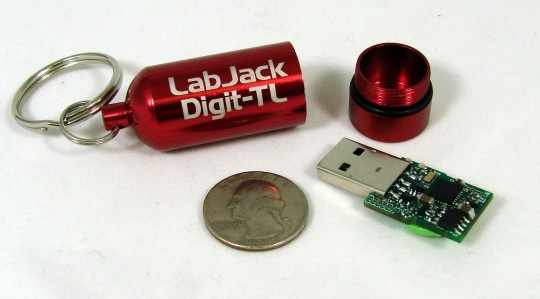
You can see that the circuit board is close to the size of a USD Quarter. Slip it into a jacket pocket, or toss it in the glove box to monitor temperature on the go. The rubber o-ring provides a highly water resistant seal. Included with the aluminum enclosure are two extra o-rings that can be used as backup or spare seals. Remove the extra O-rings from the enclosure before use.
6 Month Outdoor Reliability Test
Back in January when we first started selling Digit devices, someone decided to stow one outside partially under a rock to see how it'd hold up. Well after about 7 months, the results were collected, and you can see them below. The rock covered about half of it, so the discoloration on the enclosure is from the sun on the exposed half.
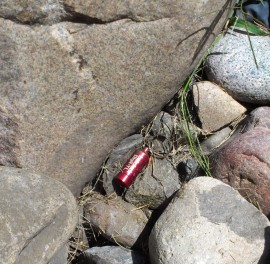
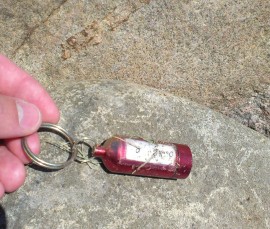
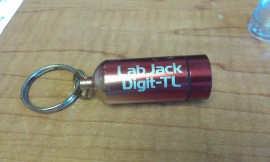
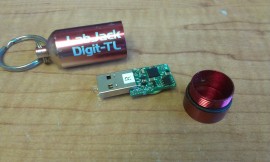
Data
Temperature data for Colorado from January to late July.
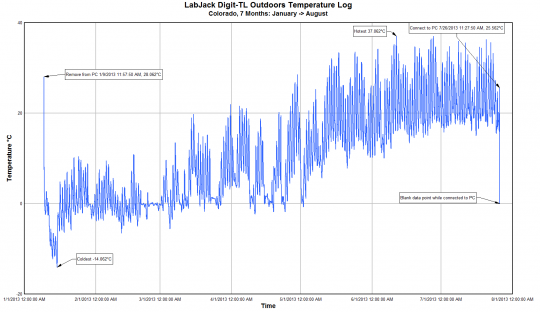
Data was collected at a 10 minute interval, and only temperature was being logged. Each day is a small spike, and then within each day (can't be seen at this zoom level), it is possible to see when the sun passed from direct contact with the Digit, to only hitting the rock above (shaded).
As the season changes from winter to summer, the average temperature increases, nothing too surprising, but it's always good to verify that the hardware is reliable, even in outdoor conditions. Read more on the related blog post.
